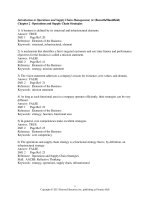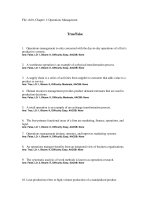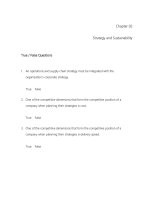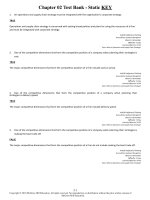Introduction to operations and supply chain management 3e bozarth chapter 15
Bạn đang xem bản rút gọn của tài liệu. Xem và tải ngay bản đầy đủ của tài liệu tại đây (327.7 KB, 25 trang )
Developing Products and Services
Chapter 15
Chapter Objectives
Be able to:
Explain why product design is important to the success of a business.
Describe the six dimensions of product design that are of particular interest to
operations and supply chain managers.
Describe the five phases of product and service development and explain the
difference between sequential development and concurrent engineering.
Discuss the different roles played by areas such as engineering and accounting
during the development process.
Describe some of the most common approaches to improving product and
service designs, including the Define-Measure-Analyze-Design-Verify (DMADV)
process, quality function deployment (QFD), design for manufacturability
(DFM), and target costing.
Copyright © 2013 Pearson Education, Inc. publishing as Prentice Hall
15 - 2
Product Design and
Development
Product Design – The characteristics or features of a
product or service that determine its ability to meet
the needs of the user.
Product Development Process– The overall process
of strategy, organization, concept generation,
product and marketing plan creation and
evaluation, and commercialization of a new
product. © Product Development and Management Association
Copyright © 2013 Pearson Education, Inc. publishing as Prentice Hall
15 - 3
Four Reasons for Developing
New Products and Services
New products or services can give firms a
competitive advantage in the marketplace.
New products or services provide benefits to the
firm.
Companies develop new products or services to
exploit existing capabilities.
Companies can use new product development to
block out competitors.
Copyright © 2013 Pearson Education, Inc. publishing as Prentice Hall
15 - 4
Product Design Dimensions
Repeatability
Testability
Serviceability
Product volumes
Product costs
Match between the design and existing capabilities
Copyright © 2013 Pearson Education, Inc. publishing as Prentice Hall
15 - 5
Product Design Dimensions
Repeatability
Consistent production
Tolerance to manufacturing variations (robustness)
Testability
Ease with which critical components or functions can be
tested during production
Serviceability
Ease of repair, service, and evaluation
Copyright © 2013 Pearson Education, Inc. publishing as Prentice Hall
15 - 6
Product Design Dimensions
Product Volumes
Expanding firm’s operations by building facilities, hiring
workers, buying new equipment, or planning with key
suppliers
Product Costs
Obvious costs – Easiest to see and manage
Hidden costs – Not easy to track but can have a major impact
• Number of parts in a product
• Engineering changes
• Transportation costs
Copyright © 2013 Pearson Education, Inc. publishing as Prentice Hall
15 - 7
Product Design Dimensions
Match with Existing Capabilities
Product design flexibility
• Easy to add features?
• Easy to upgrade?
Process flexibility
• Share processes / parts?
• Will upgrades make current operations obsolete?
Copyright © 2013 Pearson Education, Inc. publishing as Prentice Hall
15 - 8
Development Process
Concept development phase – The company
identifies ideas for new or revised products and
services.
Planning phase – The company begins to address
the feasibility of a product or service.
Design and development phase – The company
starts to invest heavily in the development effort
and builds and evaluates prototypes.
Copyright © 2013 Pearson Education, Inc. publishing as Prentice Hall
15 - 9
Development Process
Commercial preparation phase – The firms start to
invest heavily in the operations and supply chain
resources needed to support the new product or
service.
Launch phase – For products, this means “filling up”
the supply chain with products. For services, it
means making the services available to the target
marketplace.
Copyright © 2013 Pearson Education, Inc. publishing as Prentice Hall
15 - 10
Development Process Phases
Table 15.1
Copyright © 2013 Pearson Education, Inc. publishing as Prentice Hall
15 - 11
Sequential Development
vs. Concurrent Engineering
Sequential development – A process in which a
product or service idea must clear specific hurdles
before it can go on to the next development phase.
Concurrent engineering – A process where activities
in different development stages are allowed to
overlap with one another, shortening the total
development time.
Copyright © 2013 Pearson Education, Inc. publishing as Prentice Hall
15 - 12
Concurrent Engineering
Figure 15.1
Copyright © 2013 Pearson Education, Inc. publishing as Prentice Hall
15 - 13
Organizational Roles
Engineering – Provide the expertise.
Marketing – Understanding the marketplace.
Accounting – Play the role of “scorekeeper.”
Finance – Judge the financial impact and determine how to
acquire the needed capital.
Designers – Handle product design and create “identities” for
companies, environments, and service experiences.
Purchasing – Identify the best suppliers and sign them up
early in the process. Act as a consultant for materials.
Suppliers – Bring opportunities for improvement, reduce
financial risks, save time in development.
Copyright © 2013 Pearson Education, Inc. publishing as Prentice Hall
15 - 14
DMADV
Steps:
Define – Measure – Analyze – Design – Verify
• Define the project goals and customer deliverables
• Measure and determine customer needs and
specifications
• Analyze the product or process options to meet the
customer needs
• Design the product or process
• Verify the results
Copyright © 2013 Pearson Education, Inc. publishing as Prentice Hall
15 - 15
Quality Function Deployment
Quality function deployment – A graphical tool used
to help organizations move from vague notions of
what customers want to specific engineering and
operational requirements
Also called the House of Quality
Copyright © 2013 Pearson Education, Inc. publishing as Prentice Hall
15 - 16
Quality Function Deployment
QFD Matrix:
Left side: Shows customer requirements and their relative
importance to target customers.
Along the top: Lists specific product characteristics.
Main body: Shows how each of the product characteristics
does or does not support the customer requirements.
Roof: Shows synergies between some of the features.
Copyright © 2013 Pearson Education, Inc. publishing as Prentice Hall
15 - 17
Quality Function Deployment
QFD Matrix
for a Cell
Phone
Figure 15.2
Copyright © 2013 Pearson Education, Inc. publishing as Prentice Hall
15 - 18
Quality Function Deployment
Using QFD
Matrices to
move from
Customer
Requirements
to Process
Specifications.
Figure 15.3
Copyright © 2013 Pearson Education, Inc. publishing as Prentice Hall
15 - 19
Computer-Aided Systems
Computer-aided design (CAD) – An information
system that allows engineers to develop, modify,
share, and even test designs in a virtual world.
Computer-aided design/computer-aided
manufacturing system (CAD/CAM) – An extension of
CAD where CAD-based designs are translated into
machine instructions, which are then fed
automatically into computer-controlled
manufacturing equipment.
Copyright © 2013 Pearson Education, Inc. publishing as Prentice Hall
15 - 20
Design for… Approaches
Design for manufacturability (DFM)
Considering manufacturing issues in design and
development.
• Parts standardization, modular architecture.
Design for maintainability (DFMt) –
Considering maintainability issues over the product’s
projected life cycle during the design and development
process.
Copyright © 2013 Pearson Education, Inc. publishing as Prentice Hall
15 - 21
Design for… Approaches
Design for Six Sigma (DFSS)
Considering achieving Six Sigma quality levels in
product and process design.
Design for the environment (DFE)
Considering environmental, safety, and health issues over
the product’s projected life cycle during the design and
development process.
Copyright © 2013 Pearson Education, Inc. publishing as Prentice Hall
15 - 22
Target Costing and
Value Analysis
Target costing – The process of designing a product to meet a
specific cost objective.
Setting the planned selling price and subtracting the
desired profit as well as marketing and distribution costs.
Value analysis – The process of examining all elements of a
component, an assembly, an end product, or a service to
make sure it fulfills its intended function at the lowest total
cost.
Value = function/cost
Copyright © 2013 Pearson Education, Inc. publishing as Prentice Hall
15 - 23
Developing Products and Services
Case Study
Design for Supply Chain
Programs
Copyright © 2013 Pearson Education, Inc. publishing as Prentice Hall
15 - 24
All rights reserved. No part of this publication may be reproduced, stored in a retrieval system, or
transmitted, in any form or by any means, electronic, mechanical, photocopying, recording, or
otherwise, without the prior written permission of the publisher.
Printed in the United States of America.
Copyright © 2013 Pearson Education, Inc. publishing as Prentice Hall
15 - 25









